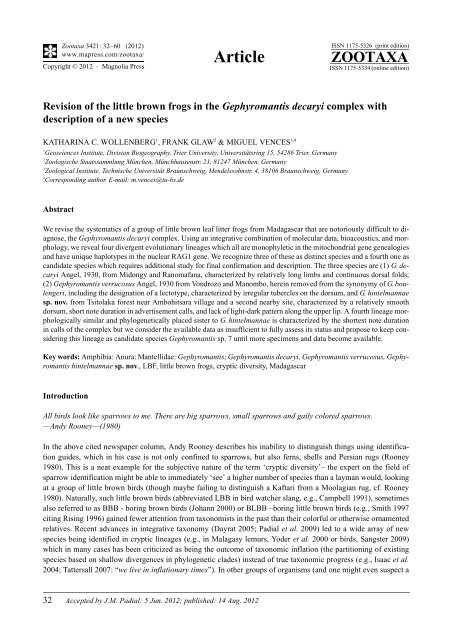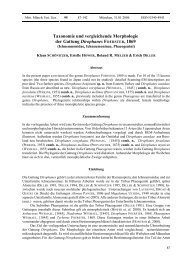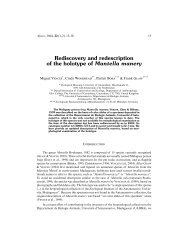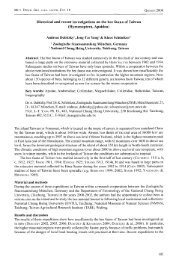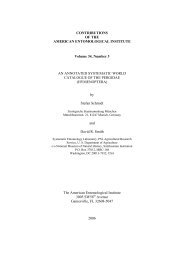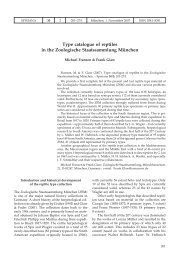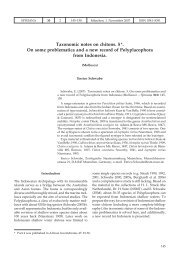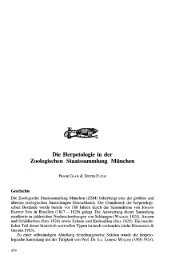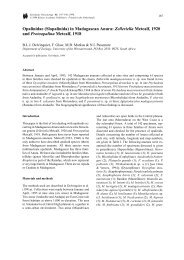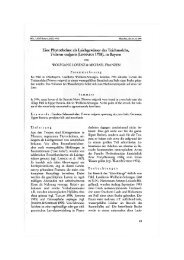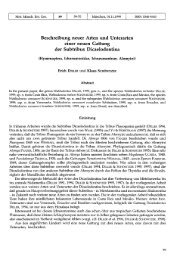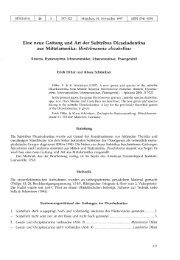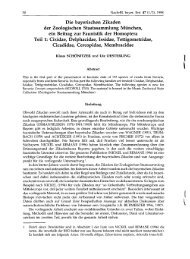View - Zoologische Staatssammlung München
View - Zoologische Staatssammlung München
View - Zoologische Staatssammlung München
Create successful ePaper yourself
Turn your PDF publications into a flip-book with our unique Google optimized e-Paper software.
Zootaxa 3421: 32–60 (2012)www.mapress.com/zootaxa/Copyright © 2012 · Magnolia PressArticleISSN 1175-5326 (print edition)ZOOTAXAISSN 1175-5334 (online edition)Revision of the little brown frogs in the Gephyromantis decaryi complex withdescription of a new speciesKATHARINA C. WOLLENBERG 1 , FRANK GLAW 2 & MIGUEL VENCES 3,41Geosciences Institute, Division Biogeography, Trier University, Universitätsring 15, 54286 Trier, Germany2<strong>Zoologische</strong> <strong>Staatssammlung</strong> München, Münchhausenstr. 21, 81247 München, Germany3Zoological Institute, Technische Universität Braunschweig, Mendelssohnstr. 4, 38106 Braunschweig, Germany4Corresponding author. E-mail: m.vences@tu-bs.deAbstractWe revise the systematics of a group of little brown leaf litter frogs from Madagascar that are notoriously difficult to diagnose,the Gephyromantis decaryi complex. Using an integrative combination of molecular data, bioacoustics, and morphology,we reveal four divergent evolutionary lineages which all are monophyletic in the mitochondrial gene genealogiesand have unique haplotypes in the nuclear RAG1 gene. We recognize three of these as distinct species and a fourth one ascandidate species which requires additional study for final confirmation and description. The three species are (1) G. decaryiAngel, 1930, from Midongy and Ranomafana, characterized by relatively long limbs and continuous dorsal folds;(2) Gephyromantis verrucosus Angel, 1930 from Vondrozo and Manombo, herein removed from the synonymy of G. boulengeri,including the designation of a lectotype, characterized by irregular tubercles on the dorsum, and G. hintelmannaesp. nov. from Tsitolaka forest near Ambohitsara village and a second nearby site, characterized by a relatively smoothdorsum, short note duration in advertisement calls, and lack of light-dark pattern along the upper lip. A fourth lineage morphologicallysimilar and phylogenetically placed sister to G. hintelmannae is characterized by the shortest note durationin calls of the complex but we consider the available data as insufficient to fully assess its status and propose to keep consideringthis lineage as candidate species Gephyromantis sp. 7 until more specimens and data become available.Key words: Amphibia: Anura: Mantellidae: Gephyromantis; Gephyromantis decaryi, Gephyromantis verrucosus, Gephyromantishintelmannae sp. nov., LBF, little brown frogs, cryptic diversity, MadagascarIntroductionAll birds look like sparrows to me. There are big sparrows, small sparrows and gaily colored sparrows.—Andy Rooney—(1980)In the above cited newspaper column, Andy Rooney describes his inability to distinguish things using identificationguides, which in his case is not only confined to sparrows, but also ferns, shells and Persian rugs (Rooney1980). This is a neat example for the subjective nature of the term ‘cryptic diversity’– the expert on the field ofsparrow identification might be able to immediately ‘see’ a higher number of species than a layman would, lookingat a group of little brown birds (though maybe failing to distinguish a Kaftari from a Moolagian rug, cf. Rooney1980). Naturally, such little brown birds (abbreviated LBB in bird watcher slang, e.g., Campbell 1991), sometimesalso referred to as BBB - boring brown birds (Johann 2000) or BLBB –boring little brown birds (e.g., Smith 1997citing Rising 1996) gained fewer attention from taxonomists in the past than their colorful or otherwise ornamentedrelatives. Recent advances in integrative taxonomy (Dayrat 2005; Padial et al. 2009) led to a wide array of newspecies being identified in cryptic lineages (e.g., in Malagasy lemurs, Yoder et al. 2000 or birds, Sangster 2009)which in many cases has been criticized as being the outcome of taxonomic inflation (the partitioning of existingspecies based on shallow divergences in phylogenetic clades) instead of true taxonomic progress (e.g., Isaac et al.2004; Tattersall 2007: “we live in inflationary times”). In other groups of organisms (and one might even suspect a32 Accepted by J.M. Padial: 5 Jun. 2012; published: 14 Aug. 2012
lower level of public interest), the advances in understanding biological diversity mirror these processes discussedin birds and primates. For instance, the small body sizes, unobtrusive behavior and cryptic coloration of leaf litterfrogs render few phenotypic characteristics to distinguish species of LBF (little brown frogs, as first used by Schicket al. 2010), but due to integrative taxonomic methods, many such cases of cryptic diversity have been unveiled(e.g., Elmer et al. 2007; Meegaskumbura et al. 2002; Meegaskumbura & Manamendra-Arachchi 2005; Padial & dela Riva 2009; Vieites et al. 2009; Zimkus & Schick 2010).Undoubtedly, assigning species status to cryptic lineages within incompletely defined species includes the riskof overvaluing intraspecific variation. Yet certain levels of divergence provide a probabilistic means to identifyindividuals or genealogical lineages that may have attained species status, and to flag these as candidate species forfurther study (Fouquet et al. 2007; Wollenberg et al. 2008; Vieites et al. 2009).Unobtrusive Malagasy frog lineages like Boophis (green or brown tree frogs), Mantidactylus (very diverse inlife styles and body sizes, but mostly dull-colored), cophyline frogs (mostly small, brown, terrestrial or arboreal),or the genus Gephyromantis (small, brown, leaf litter frogs with terrestrial development mode) are such examplescontaining cryptic lineages. Currently, 38 nominal species of Gephyromantis (family Mantellidae) are recognized(Glaw & Vences 2007; Crottini et al. 2011; Glaw & Vences 2011; Glaw et al. 2011; Vieites et al. 2012). In themonophyletic subgenus Gephyromantis, nine confirmed candidate species (CCS) were identified by Vieites et al.(2009), while in three genealogical lineages (DCL = deep conspecific lineages; Vieites et al. 2009) deep geneticdivergence is not accompanied by further character divergence, so that species description in these cases might notbe warranted. Given the high morphological similarity of many Gephyromantis species, integrating different linesof evidence and different sets of characters – e.g., morphology, bioacoustics, mitochondrial and nuclear DNAsequences—is the most appropriate approach to species delimitation and description (Padial et al. 2010) and hasalready led to the description of four new species of Gephyromantis in the last years (Crottini et al. 2011; Glaw &Vences 2011; Glaw et al. 2011; Vieites et al. 2012).In this paper, we revise the systematics of the Gephyromantis decaryi complex. We use this name for convenienceto refer to a clade within the subgenus Gephyromantis comprising G. decaryi and three candidate speciesnamed G. sp. 7, G. sp. 8, and G. sp. 9, based on the analysis of Vieites et al. (2009) and Kaffenberger et al. (2012).We show that although these frogs look virtually identical at first glance, they are in fact characterized by concordantdifferences in all of the character sets analyzed, supporting specific distinctness in three cases.Material and methodsFrog specimens were collected at night by opportunistic searching, using torches and head lamps. Specimens wereeuthanized in a chlorobutanol solution, fixed in 95% ethanol, and preserved in 70% ethanol. Localities were georeferencedwith GPS receivers using the WGS84 datum system and plotted on schematic maps. Specimens studiedin this paper are deposited in the collections of the Université d'Antananarivo, Département de Biologie Animale,Antananarivo (UADBA), Zoölogisch Museum Amsterdam (ZMA), and the <strong>Zoologische</strong> <strong>Staatssammlung</strong> München(ZSM). FGMV, FGZC and ZCMV refer to F. Glaw and M. Vences field numbers. Terminology for biogeographicregions of Madagascar follows Boumans et al. (2007).Morphology. Morphological measurements (in millimeters) were all done by KCW with digital calipers (precision0.01 mm) to the nearest 0.1 mm. Abbreviations for morphological characters are: SVL (snout-vent length),HW (greatest head width), HL (head length), ED (horizontal eye diameter), END (eye-nostril distance), NSD (nostril-snouttip distance), NND (nostril-nostril distance), TD (horizontal tympanum diameter), TL (tibia length, actuallyreferring not to the tibia bone but to the shank), HAL (hand length), HIL (hindlimb length), FOL (foot length),FOTL (foot length including tarsus), FORL (forelimb length), and RHL (relative hindlimb length). The definitionof these measurements, terminology and description scheme follow previous works (Glaw & Vences 2000, 2002;Vences & de la Riva 2007). Definition of inner and outer dorsolateral ridges follows the scheme of Vences & Glaw(2001). A list of specimens measured is provided in Table 1.Bioacoustics. Calls were recorded in the field either using a Sony WM-D6C Professional Walkman with externalmicrophone, or an Edirol R09 digital recorder with internal microphone. Recordings were sampled or re-sampledat 22.05 kHz and 16-bit resolution and computer-analyzed using the software CoolEdit / Adobe Auditionversion 1.5. Spectrograms were obtained at Hanning window function with 256 bands resolution. Temporal mea-REVISION OF THE GEPHYROMANTIS DECARYI COMPLEXZootaxa 3421 © 2012 Magnolia Press · 33
surements are given as range, with mean ± standard deviation in parentheses. Definition of variables and terminologyin call descriptions follow Köhler (2000). Classification of call types was done according to the social contextobserved during calling and the researchers' experience. Advertisement calls were those emitted regularly underusual mating conditions without extraordinary dense male aggregations. For most call recordings, no reliable temperaturedata were taken due to various practical reasons, mostly because specimens were heard and recorded in thecourse of other projects or in suboptimal conditions, such as during a heavy cyclone rainfall in Manakara. As wewill discuss below we are aware that this might be an impediment to interpreting the bioacoustic differencesbetween species, but we are also convinced that many of the differences observed are valid because we hypothesizeinter-species differences to be higher than temperature-dependent variation within species. Definitions of units inthe vocalizations are largely based on the rationale in Glaw & Vences (1994). We have observed in numerous casesthat species of the subgenus Gephyromantis emit well-delimited series of short sounds. Each of these sounds correspondsto one expiration (as ascertained by vocal sac movement) and although the number of sounds per series issomewhat variable, its variation within species is often lower than differences among species. We therefore considerone such series as a call, and each of the sound components produced by one expiration as note. We feel thatthis definition best fits the biological reality in these frogs since each note so defined corresponds to one homologousand well-defined signal, and each call so defined can be hypothesized to be homologous to the much shortercalls of other Gephyromantis which consist of only a few rapidly repeated notes (e.g., in G. boulengeri and G. leucocephalus).DNA extraction and sequencing. Total genomic DNA was extracted using proteinase K (final concentration1 mg/mL), and isolated by a standard salt extraction protocol (Bruford et al. 1992). A fragment of the mitochondriallarge ribosomal subunit or 16S rRNA (16S) was amplified via polymerase chain reaction (PCR) using theprimers 16Sar-L and 16Sbr-H (Palumbi et al. 1991). A portion of the mitochondrial cytochrome-b gene (COB) wasamplified using the primers cytb-c (5’-CTACTGGTTGTCCTCCGATTCATGT-3’) and CBJ-10933 (5’-TATGT-TCTACCATGAGGACAAATATC-3’); a fragment of the nuclear RAG1 gene was amplified using the primersAmp-F1 and Amp-R2 (for primer sequences and thermocycling conditions see Chiari et al. 2004). Sequence datacollection and visualization were performed on ABI 3130 automated sequencers (Applied Biosystems). Sequenceswere deposited in GenBank (Table 3).Data analysis. Our final alignment contained 503bp of 16SrRNA, 576bp of COB, and 738bp of RAG1, fornumerous specimens of the G. decaryi complex (with populations from the Ranomafana area, Ambohitsara, Manakara,and Manombo), as well as specimens for other species of the genus Gephyromantis and other Malagasy frogsas hierarchical outgroup taxa (Table 3).For the 16S and COB datasets, we used the FINDMODEL tool at the HIV databases (http://hcv.lanl.gov/content/sequence/findmodel/findmodel.html,accessed 12-20-2010) to compute the best-fit model of evolution usingAIC. For the 16S dataset, FINDMODEL selected the GTR+G model of evolution (-lnL = 1392.335122, AIC =2802.670244, alpha = 0.12438), for the COB dataset, the HKY+G model of evolution was selected (-lnL =1365.877952, AIC = 2741.755904, alpha = 0.13140). Phylogenetic analyses were performed using Mrbayes 3.1(Bayesian analysis, Ronquist & Huelsenbeck 2003) and PhyML (Maximum Likelihood) with 1000 bootstrap replicates(Guindon & Gascuel 2003). PhyML was accessed via the online interface of the HIV databases (http://www.hiv.lanl.gov/content/sequence/PHYML/interface.html, accessed 12-20-2010), MrBayes (using a hybridMrBayes code, Pratas et al. 2009) was accessed online via the CIPRES science gateway v3.1 (Miller et al. 2009)and run on the NSF ABE Teragrid Resource. Bayesian analyses consisted of four Markov chains that ran for10×10 6 generations, sampled every 100 generations, with a random starting tree and default priors. The burn-in wasempirically estimated by plotting –ln L against the generation number, and the trees corresponding to the first 5million generations discarded. For interpreting these phylogenetic trees, we considered bootstrap values of 70%and higher, and Bayesian support values of 0.95 and higher, as relevant support. Due to the lower sequence variabilityin the RAG1 dataset, we decided to construct a minimum spanning network instead of a phylogenetic treeusing the software TCS (Clement et al. 2000) using sequences of specimens of the G. decaryi complex and one G.leucocephalus for comparison. Prior to TCS analysis, the dataset was phased using the PHASE algorithm inDNASP v5 (Librado & Rozas 2009) to obtain haplotypic sequences.Our analyses were performed on the DNA sequences from each gene separately because: (1) The major focus ofthis paper is on species delimitation, not on detailed phylogenetic reconstruction for which data sets with additionalgenes are more useful (such as in Kaffenberger et al. 2012). Analyzing the nuclear vs. mitochondrial dataset is34 · Zootaxa 3421 © 2012 Magnolia PressWOLLENBERG ET AL.
REVISION OF THE GEPHYROMANTIS DECARYI COMPLEXZootaxa 3421 © 2012 Magnolia Press · 35
more informative for understanding whether congruent genealogies are suggested by these independent markers.(2) Sequences of COB and 16S could not be obtained for all individuals, respectively, and a combined data setwould therefore have contained numerous missing data which can lead to an erroneous representation of branchlengths in the trees.ResultsMolecular diversity and phylogenetic relationships. Monophyly of the G. decaryi complex was recovered by the16S analysis of Vieites et al. (2009), and by the multi-gene analysis of Kaffenberger et al. (2012), in both casesbased on only single sequences per species and candidate species. This result was confirmed by our analysis of alarger sample of COB as well as 16S sequences herein (Fig. 1). Note however, that based on our reanalysis, theidentity of G. decaryi as used herein differs from that in Vieites et al. (2009) and we therefore here avoid using thecandidate species names introduced in that study.The G. decaryi complex is sister to a clade of frogs containing G. leucocephalus. The molecular markers thuscongruently indicate that the studied populations from the Ranomafana area (including Vohiparara), Ambohitsara,Manakara, and Manombo all characterized by a low note repetition rate and high number of notes in advertisementcalls (see below) represent a monophyletic group. Mitochondrial sequences (COB) of specimens from near Ankazorokanabecame available upon completion of the analyses and are therefore not included in the tree; however,they were identical to those from Ambohitsara.Genetic distances within the G. decaryi complex are low and the phylogenetic relationships within the complexcould not be resolved. Differences among Bayesian and ML phylogeny reconstruction methods affected the topologyonly outside the G. decaryi complex – in the COB fragment, ML placed G. eiselti, G. thelenae and G. boulengeriin a clade with high bootstrap values that is situated basal to all other studied Gephyromantis (not shown). Forthis paper, however these incongruences are of no relevance and detailed phylogenetic relationships within Gephyromantishave been assessed elsewhere based on a more comprehensive multi-gene data set (Kaffenberger et al.2012).Specimens from the studied populations within the G. decaryi complex constituted four distinct monophyleticgroups in the mtDNA analyses, and each of the groups was characterized by a unique haplotype of the nuclear geneRAG1 (Fig. 1). We will here refer to these units for convenience by the names of their localities; in the respectivespecies accounts below we provide further information on how they were named and referred to in previous papers(Glaw & Vences 2007; Vieites et al. 2009; Kaffenberger et al. 2012). Lineages were distributed among the fourprincipal localities as follows: (1) Ranomafana (including Vohiparara), (2) Ambohitsara and Ankazorokana; (3)Manakara; and (4) Manombo and Vondrozo. Because no haplotype sharing was observed among these four groupsin mitochondrial and nuclear DNA, the molecular analyses thus support their status as independent evolutionarylineages, and in the following we will seek for further support of this hypothesis from bioacoustics and morphology.Bioacoustic divergence. Bioacoustically, the G. decaryi species complex is characterized by a high number ofnotes in advertisement calls (>30) and low note repetition rate (3.6–4.6/s). These two characters are superficiallysimilar in three other species of Gephyromantis (G. eiselti, G. enki, G. thelenae), but their note repetition rate islower (0.5–2.3/s), G. eiselti and G. thelenae have shorter calls consisting of only 5–21 notes, and calls of G. enkihave about 40 notes which is less than in most species of the G. decaryi complex.In general, to the human ear, vocalizations recorded from Ranomafana, Ambohitsara/Ankazorokana, andManombo/Vondrozo sound rather similar. As will be described in the species accounts below more in detail and isshown in Figs. 2–3, calls were long and rather slow series of 30–120 notes with a noisy, indistinctly pulsed structure.In contrast, vocalizations from the Manakara candidate species sound quite different and were characterizedby a much shorter note duration (Figs. 2–3; Table 2).36 · Zootaxa 3421 © 2012 Magnolia PressWOLLENBERG ET AL.
FIGURE 1. Bayesian consensus phylogeny of the 16SrRNA fragment (A) and the COB-fragment (B) for the Gephyromantisdecaryi complex (with symbols) and other species and species complexes of the genus Gephyromantis. Outgroup taxa in thetrees are not shown (“outgroup”). Statistical support values are shown as bars on branches. Left bars, gray = Bayesian posteriorprobabilities >95, black >99, right bars, gray = Maximum Likelihood bootstrap values >75, black >90. The lower graph (C) is ahaplotype network based on sequences of the nuclear RAG1 gene. Numbers at branches indicate the number of mutationalsteps separating haplotypes.REVISION OF THE GEPHYROMANTIS DECARYI COMPLEXZootaxa 3421 © 2012 Magnolia Press · 37
FIGURE 2. Comparative oscillograms of the advertisement calls of species in the Gephyromantis decaryi complex. All oscillogramsshow a central segment of a call with 8–9 single notes. The call of G. decaryi refers to specimen ZCMV 5585; call ofG. verrucosus from Manombo refers to specimen ZCMV 5495; call of G. hintelmannae recorded from specimen ZCMV 5229.38 · Zootaxa 3421 © 2012 Magnolia PressWOLLENBERG ET AL.
TABLE 2. Numerical data of advertisement calls of species in the Gephyromantis decaryi complex. Duration of notes andintervals in milliseconds, given as mean ± standard deviation (minimum-maximum in parentheses), all based on measurementsof 10 notes respectively intervals except data from Ranomafana (taken from Glaw & Vences 2000; based on 44 notes and 43intervals).Species Locality Note duration Inter-note interval duration Dominantfrequency bandNote repetitionrateG. decaryi Vohiparara 85 ± 14(65–120) 131 ± 13 (114–178) 2950–3600 Hz n.m.G. decaryi Ranomafana 84 ± 4 (74–88) 146 ± 13 (127–170) 3000–4200 Hz 4.6/sG. sp. 7 Manakara 33 ± 5 (25–41) 231 ± 18 (209–270) 3800–5000 Hz 3.6/sG. hintelmannae Ambohitsara 92 ± 8 (81–103) 146 ± 13 (127–170) 3800–4200 Hz 3.8/sG. verrucosus Manombo 139 ± 8 (123–157) 93 ± 7 (79–102) 3800–5300 Hz 4.5/sG. verrucosus Vondrozo 145 ± 8 (132–154) 144 ± 14 (120–164) n.m. 3.7/sA closer examination of call variation revealed a remarkable congruence between bioacoustic and moleculardata. Calls from Ranomafana recorded in 1996 and analyzed by Glaw & Vences (2000) were highly similar in thetemporal and spectral characteristics to new recordings obtained in 2007 (Table 2). The populations from Vondrozoand Manombo, which were identified as the same lineage by the molecular analysis had extremely similar calls(Fig. 2–3) except a shorter inter-note interval in animals from Manombo. However, in our experience, this temporalfeature is strongly affected not only by temperature variation but even more strongly by the state of sexual motivationof the calling male, while note duration is usually a more stable and more taxonomically informative variable(e.g., Glaw et al. 2010). See the Discussion at the end of this paper for a further appreciation of possible temperatureeffects on the variation reported.The general similarity in the structure of calls from Ranomafana, Ambohitsara, and Manombo/Vondrozo alsoextends to the amplitude modulation within notes: in all recordings, a distinct peak is visible at the start of eachnote, and amplitude decreases towards the end of the note. Furthermore, notes are usually composed of a spectralband of lower intensity at rather low frequencies and a more intense band at higher frequencies (see detailed callanalyses below). Nevertheless, differences were obvious: note duration was distinctly longer in the Manombo/Vondrozorecordings as compared to those from Ranomafana and Ambohitsara (Table 2). In turn, the calls from Ambohitsarawere unique in the emission of very long calls of more than 100 notes (vs. < 80 notes). We cannot fullyexclude that this difference in note repetition rate might be partly influenced by the intrinsic motivation of themales, but it is relevant that we did not hear calls with >100 notes in the Manakara population where males werecalling with extreme motivation during very heavy rains, almost in the open, and continued calling even whenapproached by the observer.Morphological differentiation. Morphological comparisons are restricted to adult specimens because larvalstages are so far completely unknown for all species and candidate species in the G. decaryi complex. Given theircalling behavior independent from water bodies, it is probable that these frogs have a nidicolous development withnon-feeding tadpoles developing in jelly nests in the leaf litter, as demonstrated for other species of the subgenusGephyromantis (Randrianiaina et al. 2011).Because of the great variability within the G. decaryi complex in several key morphological characters ofadults, such as hindlimb length, presence of dorsolateral ridges, dorsal skin texture, and coloration (Figs. 4–9), it isnot possible to diagnose the complex as a whole by morphology alone within the subgenus Gephyromantis. However,the moderate size of these frogs (male SVL 20–28 mm; but only in two specimens < 24 mm; Table 1) distinguishesmost individuals from the smaller species G. blanci, G. eiselti, G. enki, and G. thelenae (SVL 21–23 mm).Other morphological characters distinguish single representatives of the G. decaryi complex from other Gephyromantisbut are not shared by all representatives of the complex.Within the complex, most of the candidate species can be distinguished by discrete states of morphologicalcharacters: The frogs from the Ranomafana region are slender with comparatively very long limbs (Fig. 8) as evidencedby the morphometric analysis (Fig. 5). They furthermore have quite distinct inner and outer dorsolateralridges that often are continuous and bordered by black, in most cases a distinct pattern of irregular darker markingsand patches on the back, and distinct dark markings interrupting the light gray color on the upper lip (Fig. 7). Thefrogs from Manombo are characterized by shorter limbs, a very granular skin without distinct and continuous dor-REVISION OF THE GEPHYROMANTIS DECARYI COMPLEXZootaxa 3421 © 2012 Magnolia Press · 39
solateral folds, a usually quite contrasted dorsal pattern, and distinct dark markings interrupting the light gray coloron the upper lip. A similar color pattern and dorsal skin texture is also present in the specimens from Vondrozowhich were not available for the detailed morphometric comparisons. Furthermore, the Manombo/Vondrozo malefrogs clearly differ from the Ranomafana frogs by an externally less conspicuous femoral gland in life (Fig. 4)which is reflected by a smaller gland size in internal view (Fig. 9).FIGURE 3. Comparative sonagrams and oscillograms of the advertisement calls of species in the Gephyromantis decaryi complex,referring to the same specimens as in Fig. 2.40 · Zootaxa 3421 © 2012 Magnolia PressWOLLENBERG ET AL.
FIGURE 4. Comparative dorsolateral and ventral views of males of the four species respectively candidate species in theGephyromantis decaryi complex. (a,b) Gephyromantis decaryi from Ranomafana, specimen photographed in 2007 and preservedin the UADBA collection; (c,d) Gephyromantis verrucosus from Manombo, specimen ZSM 2508/2007 (field numberZCMV 5495); (e,f) Gephyromantis hintelmannae from Ambohitsara, holotype specimen ZSM 2500/2007 (field number ZCMV5230); (g,h) Gephyromantis sp. 7, specimen preserved in UADBA (field number ZCMV 5484).REVISION OF THE GEPHYROMANTIS DECARYI COMPLEXZootaxa 3421 © 2012 Magnolia Press · 41
FIGURE 5. Morphometric differentiation of specimens from Ranomafana (G. decaryi, open gray dots), from Ambohitsara (G.hintelmannae, filled gray dots), from Manombo (G. verrucosus, red filled dots), and Manakara (G. sp. 7, filled black dots).Polygonal shapes denote morphological differences among groups. A - G. verrucosus and G. sp. 7 differ in PCs 3 and 5; B – G.decaryi shows different PC1 / SVL values as compared to all other species of the G. decaryi complex. C – G. hintelmannae iswell distinguished from G. sp. 7 by the residuals of TL and HL, but shows some overlap with specimens belonging to G. verrucosus.The specimens from Ambohitsara/Ankazorokana and Manakara have shorter limbs, a relatively smooth dorsumwith only small though distinct tubercles usually not forming dorsolateral ridges, a rather uniform dorsal color,and often the dark markings on the light upper lip are absent or small. If defining the discrete and genetically highlydivergent clusters from the molecular analysis as candidate species, all of these can be distinguished by morphologyexcept for those from Ambohitsara and Manakara.To infer the differentiation within the G. decaryi complex in morphometric characters, we computed residualsof all measured variables to SVL. These residuals were subjected to a Principal Component analysis in a varimaxrotatedcoordinate system, which yielded five PCs with Eigenvalues >1 (5.41, 2.09, 1.38, 1.35, and 1.02). Variableswhich contributed to these five PCs with high loadings (>0.68) were for PC1 – the hind limb measures HiL, FOT,FOL, TL, Rhl; for PC2 – TD; for PC3: HW, NND; for PC4 – NSD, FOR; and for PC5 – END. These PCs togetherexplained 86.7% of total variance. We used these PCs together or in combination with raw residuals of the originalvariables and SVL to further illustrate morphometric differentiation among lineages of the G. decaryi complex.With the exception of the populations from Ambohitsara and from Manombo (which are geographically furtherapart from each other than e.g., Ambohitsara and Manakara, or Ranomafana), all populations showed non-overlappingranges of some measurement residuals (Fig. 5).Taxonomy and rationale for species delimitationBecause of the high congruence between molecular, bioacoustic and morphological evidence, we conclude that theG. decaryi complex consists of more than one species. The most convincing evidence for species status of any pair42 · Zootaxa 3421 © 2012 Magnolia PressWOLLENBERG ET AL.
of the candidate species identified within the complex would be their sympatric occurrence without admixture;however, no such record is known to date. With regard to their morphology, two of the candidate species (fromRanomafana and Manombo/Vondrozo) are most clearly differentiated from each other (by skin texture and limblength). Furthermore, they are arranged basally as separate units in the multigene phylogeny of Kaffenberger et al.(2012). For these two candidate species, call recordings are available from different localities and collecting periods,demonstrating constancy of the bioacoustic differences. Furthermore, the mitochondrial differentiation ofthese two lineages to each other and to the other two is at a level (>2%) that, albeit low, is known to characterizealso other closely related sister species of mantellid frogs of undoubted species status due to their syntopic occurrence,such as Gephyromantis eiselti and G. thelenae (Wollenberg & Harvey 2010; Wollenberg et al. 2011).The situation is different for the remaining two lineages from Ambohitsara/Ankazorokana and Manakara.These form a highly supported monophyletic group in the multigene phylogeny of Kaffenberger et al. (2012) andtheir mitochondrial differentiation is even lower (1.5% in the 16S gene). Furthermore, although our data supportboth bioacoustic and morphological differentiation among these two forms, the information on the Manakara populationis rather fragmentary. To the human ear their calls sound different but both lineages have relatively similartemporal call parameters, and calls from Manakara were emitted under extreme environmental conditions (heavyrain from a cyclone). Furthermore, both these lineages share some morphological features, such as a rather smoothback and absence of cross bands on upper lips.Given this situation, we here propose to consider three of the lineages in the G. decaryi complex as species, andto continue considering one (from Manakara) as candidate species (G. sp. 7; following the name designation in Vieiteset al. 2009 and Kaffenberger et al. 2012), postponing its formal taxonomic description or, alternatively, itstransfer into the DCL (deep conspecific lineage) category to future revisions based on more complete sampling.Comparisons with historical type material (see accounts below) revealed that one of the three lineages to be distinguishedat the species level (the one from Ranomafana) most closely corresponds to the type material of G. decaryiAngel, 1930 and is therefore referred to this species; the specimens from Manombo and Vondrozo perfectly agreewith the type material of G. verrucosus Angel, 1930, and we therefore resurrect this nomen as valid name for thesetwo populations. No previous nomen is available for the population from Ambohitsara/Ankazorokana which istherefore described in the following as G. hintelmannae sp. nov.Gephyromantis decaryi Angel, 1930Identity. Gephyromantis decaryi was described by Angel (1930) on the basis of four specimens collected by R.Decary from forest near Midongy du Sud (= Midongy Atsimo) at 500–700 m a.s.l. (MNHN 1930.435) and a forestat Pic d'Ivohibe (Andringitra Massif, ca. 1100 m a.s.l.) in the South East of Madagascar (MNHN 1930.436-438).Blommers-Schlösser & Blanc (1991) assigned the species to the genus Mantidactylus and designated the (female)specimen from Midongy (MNHN 1930.435) as lectotype. As reported in detail by Glaw & Vences (2000), the lectotypeis currently in a very poor state of preservation, with dissociated and partially missing hindlimbs. Furthermore,the original description (Angel 1930) provides a joint description for a total of four syntypes, of which threecome from a highland locality (Pic d'Ivohibe) and probably are not conspecific with the lectotype. To assign thislectotype specimen and thus the nomen decaryi to any of the species that we have identified by molecular and bioacousticdata, we therefore can only use indirect evidence. The coloration characters mentioned by Glaw & Vences(2000) and derived from their examination of the lectotype are rather unspecific and in principle could apply to anyof the species identified by us. There are two lines of evidence, however, supporting the species definition of Glaw& Vences (2000): (1) The lectotype upon examination in 1999 had a slightly converging dark-bordered ridge oneach side of the neck that is followed dorsolaterally by a further ridge. This character is most clearly expressed inthe specimens from the Ranomafana region, although also some specimens from Manombo have irregular expressionsof such ridges. (2) The original description (Angel 1930) describes G. decaryi as a species with longhindlimbs, with the tibiotarsal articulation widely surpassing the snout tip when limbs are adpressed along body.Although this was probably written mainly referring to the paralectotype specimen MNHN 1930.437, a male withvery long hindlimbs (see Glaw & Vences 2000), a comparatively large hindlimb length also appears to characterizethe lectotype. Its poor state of preservation did not allow to take a full range of measurements, but we here give anumber of measurements of the lectotype (MNHN 1930.435) kindly provided by A. Miralles who examined thespecimens in 2010 (all in mm): SVL 22.1, FOTL (only left hindlimb) 22.0, TL (on left and right hindlimb)REVISION OF THE GEPHYROMANTIS DECARYI COMPLEXZootaxa 3421 © 2012 Magnolia Press · 43
14.4–14.7 (Fig. 12). Relative FOTL and TL (as FOTL/SVL and TL/SVL ratios) are thus 1.0 and 0.65–0.67, in perfectagreement with the values of specimens from Ranomafana National Park assigned to G. decaryi: 0.87–0.96 forrelative FOTL, and 0.59–0.69 for relative TL. In comparison, relative FOTL is
Advertisement calls. Glaw & Vences (2000) described the call of Gephyromantis decaryi (under the nameMantidactylus decaryi) based on recordings from 26 February 1996 at Ranomafana. Temporal data from thisdescription are reproduced in Table 2. One call consisted of 44 notes, each peaking in intensity at its beginning.Fundamental frequency was 1450–1650 Hz, dominant frequency was 2950–3600 Hz.Own recordings from the campsite next to Valbio biological station (from specimen ZCMV 5585) largely agreewith this previous description (see Table 2 for temporal call data). Note repetition rate was 4.6/s. The notes had avery indistinctly pulsed structure, with 14–16 intensity peaks per note (n=3) that can be regarded as pulses. A fundamentalfrequency band was present at 1800–2000 Hz, dominant frequency ranges between 3000–4200 Hz, somelow intensity components seemed to reach up to 8000 Hz.Distribution. So far known from two geographically quite distant localities, Midongy du Sud (the type locality)and Ranomafana National Park. In Ranomafana, the species is locally common at mid-elevations (ca.600–1050 m a.s.l.), but clearly has a more fragmented area of occupancy than other species of Gephyromantis,such as G. enki.Gephyromantis verrucosus Angel, 1930Resurrection, identity and lectotype designation. Gephyromantis verrucosus, considered a synonym of G. boulengerifor more than 60 years, is hereby resurrected and considered to represent a valid species. The two syntypesof Gephyromantis verrucosus (MNHN 1930.443 and 444) from a forest near Fort Carnot (at 600 m a.s.l.), Farafanganaprovince (= Ikongo), are adult males, as recognizable from the presence of femoral glands in both specimens,and black color laterally on throat, representing vocal sacs, in MNHN 1930.444. Since this latter specimen is larger,in better state of preservation, and the secondary sexual characters are more clearly developed, we hereby designatethis specimen as lectotype (Fig. 12).The lectotype has distinct and large dorsal tubercle, arranged in very irregular rows and especially prominentdorsolaterally. In the shoulder region, the tubercles very weakly are arranged along an imagined line representingthe inner dorsolateral ridges, but no such ridges can be reliably identified. Although color and pattern are largelyfaded on dorsal and ventral side (with some dark brown pigment remaining especially on the tubercles of the dorsolateralregion), it is possible to recognize on the left side of the head clear dark and light alternating patches on theupper lip with two distinct dark patches interrupted by a light patch under the eye. No webbing is recognizable andthe hands and feet are rather elongated and thin. Dark crossbands are recognizable dorsally on thigh, shank, andupper forelimb. The length and width of femoral glands are 4.2 x 1.9 mm in the lectotype and 3.2 x 1.8 mm in theparalectotype.The lectotype thus agrees in most morphological and chromatic characters with the specimens collected by usat Manombo and Vondrozo. These localities are in the same general region of Madagascar's south-eastern coast asthe G. verrucosus type locality Ikongo (Fig. 10). Consequently we here revalidate the name Gephyromantis verrucosusfor these populations.Remark. Vieites et al. (2009) and Wollenberg et al. (2011) considered the Vondrozo and Manombo populationsas representing G. decaryi, due to their geographical proximity to the type locality of decaryi (Midongy). Asargued above, we here instead follow Glaw & Vences (2000) and assign the name decaryi to the Ranomafana population.This species was referred to as G. sp. aff. decaryi (Vondrozo) by Kaffenberger et al. (2012).Material examined. ZSM 2507/2007 (ZCMV 5451), ZSM 2508/2007 (ZCMV 5495), ZSM 2506/2007(ZCMV 5450), ZSM 2462/2007 (ZCMV 5459), adult males, collected in Manombo, forest upstream, south-easternMadagascar, coordinates not taken but less than 4 km from 23° 01.699' S, 47° 43.892' E, at ca. 50 m above sealevel, by M. Vences, G. Safarek, E. Rajeriarison and T. Rajoafiarison on 24 February 2007; ZSM 2505/2007(ZCMV 5438), adult male, collected at the administration buildings and campsite of Manombo Reserve, southeasternMadagascar, 23° 01.699' S, 47° 43.892' E, at 44 m above sea level, by M. Vences, G. Safarek, E. Rajeriarisonand T. Rajoafiarison on 23 February 2007. ZMA 20097 (ZCMV 660), ZMA 20129 (ZCMV 662), UADBAuncatalogued (ZCMV 661), three adult males from Vondrozo village (not morphologically examined for thisstudy), 22° 49.183' S, 47°19.216' E, 198 m above sea level, collected by M. Vences and E. Rajeriarison on 9 February2004.REVISION OF THE GEPHYROMANTIS DECARYI COMPLEXZootaxa 3421 © 2012 Magnolia Press · 45
FIGURE 6. Photographs of dorsal skin structure in preserved specimens of (a) Gephyromantis decaryi (ZSM 2497/2007; fieldnumber ZCMV 5223), (b) G. verrucosus (ZSM 2462/2007; ZCMV 5459), (c) G. hintelmannae (holotype ZSM 2500/2007;ZCMV 5230), and (d) G. sp. 7 (ZSM 2492/2007; ZCMV 5485). Note continuous dorsolateral ridges in G. decaryi, discontinuousridges and elongated tubercles in G. verrucosus, and relatively smooth skin with weakly expressed ridges in G. hintelmannaeand G. sp. 7. Scale bars represent 1 mm.46 · Zootaxa 3421 © 2012 Magnolia PressWOLLENBERG ET AL.
FIGURE 7. Lateral photographs of the head in preserved specimens of the four species of the Gephyromantis decaryi complex.Same specimens pictured as in Fig. 6. Note distinct light-dark pattern of upper lip in G. decaryi and especially in G. verrucosus,and absence of this pattern in G. hintelmannae and G. sp. 7. Scale bars represent 1 mm.Diagnosis. A member of the subgenus Gephyromantis in the genus Gephyromantis on the basis of (1) presenceof intercalary elements between ultimate and penultimate phalanges of fingers and toes (verified by external examination),(2) small size (SVL below 35 mm), (3) slightly enlarged terminal discs of fingers, (4) presence of outermetatarsal tubercle, (5) absence of webbing on hands and presence of only rudimentary webbing on feet, (6) tightconnection of tissue surrounding the two lateral metatarsalia, (7) presence of femoral glands in males, (8) presenceof paired or bilobed blackish vocal sacs in males, (9) diurnal calling behavior not concentrated at water bodies.Within the subgenus, distinguished from all other species by combination of (1) comparatively small to moderatesize (male SVL 20–26 mm), (2) dorsum coarsely tubercular (the tubercles sometimes arranged such as to roughlyform interrupted inner and outer dorsolateral ridges), (3) upper lip with light gray or white color interrupted by 2–4distinct dark markings, (4) lower lip ventrally without a distinct alternating series of brown and yellowish markings;(5) dorsal color light gray with a contrasted, rather symmetrical dark pattern, (6) hindlimbs not particularlylong, not reaching beyond snout tip, (7) calls consisting of a rather long series of >30 notes of indistinctly pulsedstructure with a low note repetition rate of 3.6–4.6/s.Assigned to the group of species here informally defined as the Gephyromantis decaryi complex based on itsmolecular phylogenetic relationships (see above) and its calls consisting of long series of notes with a low note repetitionrate. Distinguished from G. decaryi by lacking inner and outer dorsolateral ridges (sometimes interruptedrows of tubercles present vs. distinct and usually not interrupted), by the small and externally indistinct femoralglands in males (vs. larger and more distinct), by shorter limbs (tibiotarsal articulation at most reaching snout tipvs. reaching beyond snout tip), and by a longer note duration (123–157 vs. 65–120 ms; see Table 2) in advertise-REVISION OF THE GEPHYROMANTIS DECARYI COMPLEXZootaxa 3421 © 2012 Magnolia Press · 47
ment calls. Distinguished from G. hintelmannae (described below) by a much more granular dorsum (large regulargranules versus smooth with small tubercles and traces of dorsolateral ridges, Fig. 6), by the small and externallyindistinct femoral glands in males (versus larger and more distinct), by the presence of distinct dark patches interruptinglight color on upper lip (versus usually absence), by usually a contrasted dorsal pattern (versus usually uniformgrayish), possibly by a lower number of notes per call (100), and by a longer note duration(123–157 vs. 81–103 ms; see Table 2) in advertisement calls. G. verrucosus is also well separated from all speciesof the G. decaryi complex, except G. hintelmannae, by morphometry (Fig. 5).FIGURE 8. Photographs of the ventral surface of feet (above) and hands (below) in the four species of the Gephyromantisdecaryi complex. Same specimens pictured as in Fig. 6. Note the distinctly longer feet of G. decaryi. All photographs to scale;scale bar represents 1 mm.Redescription. Based on adult male specimen ZSM 2508/2007 from Manombo. Specimen in excellent state ofpreservation. A tissue sample has been taken for DNA analysis on the right femur. SVL 22.1 mm. For measurementssee Table 1. Body slender, ratio of head length to head width HL/HW = 1.03, head slightly wider than body,snout pointed in dorsal view, rounded in lateral view; nostrils directed posterolaterally, slightly protuberant, canthusrostralis moderately distinct, rounded; loreal region concave; tympanum distinct, rounded, ratio of tympanumdiameter to eye diameter TD/ED = 0.56; supratympanic fold prominent; tongue ovoid, posteriorly bifid; maxillary48 · Zootaxa 3421 © 2012 Magnolia PressWOLLENBERG ET AL.
teeth present; vomerine teeth absent; choanae rounded. Arms slender, distinct single subarticular tubercles; innerand outer metacarpal tubercles distinct; fingers without webbing; relative length of fingers 1
white. Some very weak yellowish tan was present on the posterior belly, in the ventral part of the inguinal region,and on the femoral glands. The iris was rather uniformly light brown, with a small dark brown spot centrally in itslower half.FIGURE 10. Distribution map of species of the Gephyromantis decaryi complex. Midongy du Sud and Ikongo (= Fort Carnot)refer to the type localities of G. decaryi and G. verrucosus, respectively.50 · Zootaxa 3421 © 2012 Magnolia PressWOLLENBERG ET AL.
FIGURE 11. Preserved specimens of the species and candidate species in the Gephyromantis decaryi complex; left—dorsal,right—ventral view. A—G. decaryi (ZSM 2597/2007; field number ZCMV 5223); B—G. hintelmannae (holotype 2500/2007;ZCMV 5230); C—G. sp. 7 (ZSM 2492/2007; ZCMV 5485); D—G. verrucosus (ZSM 2462/2007; ZCMV 5495). Not to scale(see Table 1 for precise measurements of the specimens).FIGURE 12. Preserved lectotypes of A—G. decaryi (MNHN 1930.435) and B—G. verrucosus (MNHN 1930.444); photographstaken by A. Miralles. Note the poor state of preservation of the type of G. decaryi, with one hindlimb detached from thebody. Scale bars represent 5 mm.Variation. For differences in body size measurements see Table 1. Specimens ZSM 2462/2007 (ZCMV 5459),ZSM 2506/2007 (ZCMV 5450) and ZSM 2507/2007 (ZCMV 5451) have been dissected ventrally (presumably tocheck for internal parasites). Ventral coloration of ZSM 2505/2007 (ZCMV 5438) darker than in holotype; ZSM2507/2007 (ZCMV 5451) showing a highly contrasted dorsal pattern (but structurally similar to holotype); ZSM2505/2007 (ZCMV 5438) having more strongly developed, smaller tubercle-like interrupted dorsolateral and lateralridges and also above the eyes; color of ZSM 2505/2007 (ZCMV 5438) in preservative is a more reddishbrown than in all other specimens.Natural history. In the village of Vondrozo, specimens were calling during the day in gardens and amongshrubs, in a completely deforested area with single large fruit trees. At Manombo Special Reserve, specimens werecalling in the afternoon from shrubs and logs at low perch heights (
Manombo, calling specimens clearly were more common in clearings or at the forest edge than in dense forest.Calling males were evenly spaced. Reproduction and larval stages are unknown but the fact that calling males arenot concentrated close to water bodies suggests a possible nidicolous reproduction as in other species of the subgenusGephyromantis.Advertisement calls. Two calls from Vondrozo consisted of 31 and 40 notes each. Intensity of notes increasesfrom the first notes on, and slightly decreases again towards the end of the call. Note repetition rate was 3.7/s.Notes had the most clearly pulsed structure of all populations in the G. decaryi complex studied here, with 24–29pulses/note (n=3). A fundamental frequency band is observed between 1800–2800 Hz, whereas dominant frequencyranges between 3800–5300 Hz.The two analyzed calls from Manombo consist of 50, 64 and 71 notes arranged in a regular series plus threenotes emitted at somewhat longer intervals at the end of a call. Note repetition rate was 4.5/s. Notes were less distinctlypulsed than at Vondrozo, with 30–35 recognizable pulses (n=3).Distribution. Known from three low and mid-altitude localities in south-eastern Madagascar: (1) the typelocality Fort Carnot (Ikongo) at 600 m a.s.l., (2) Manombo Special Reserve (ca. 50 m a.s.l.), and (3) the villageVondrozo (ca. 200 m a.s.l.). We also heard calls probably referable to this species from along the road running fromVondrozo to the nearby Vevembe forest.Gephyromantis hintelmannae sp. nov.Remark. This species corresponds to the CCS Gephyromantis sp. 8 of Vieites et al. (2009) and Kaffenberger et al.(2012).Holotype. ZSM 2500/2007 (ZCMV 5230), adult male, collected in the vicinities of Ambohitsara village on theway to a forest fragment locally named Tsitolaka, south-eastern Madagascar, 21° 21.431' S, 47° 48.941' E, at ca.300 m above sea level, by K. C. Wollenberg, P. Nürnberger, E. Rajeriarison and T. Rajoafiarison on 3 March 2007.Paratypes. ZSM 2499/2007 (ZCMV 5229), and 2501/2007 (ZCMV 5231), adult males, same locality and collectorsas holotype; ZSM 2502/2007 (ZCMV 5232), ZSM 2503/2007 (ZCMV 5233), and ZSM 2504/2007 (ZCMV5235), same locality and collectors as holotype. ZSM 494–499/2009 (field numbers ZCMV 8574, ZCMV8628–8632), five males and one female from a site near Ankazorokana at geographical coordinates 21°20.127' S,48°07.663' E, 142 m a.s.l., collected on 20 February 2009 by E. Rajeriarison, T. Rajoafiarison, K.C. Wollenbergand M. Vences.Diagnosis. A member of the subgenus Gephyromantis in the genus Gephyromantis on the basis of (1) presenceof intercalary elements between ultimate and penultimate phalanges of fingers and toes (verified by external examination),(2) small size (SVL below 35 mm), (3) slightly enlarged terminal discs of fingers, (4) presence of outermetatarsal tubercle, (5) absence of webbing on hands and presence of only rudimentary webbing on feet, (6) tightconnection of tissue surrounding the two lateral metatarsalia, (7) presence of femoral glands in males, (8) presenceof paired or bilobed blackish vocal sacs in males, (9) diurnal calling behavior not concentrated at water bodies.Within the subgenus, distinguished from all other species by combination of (1) comparatively moderate size(male SVL 24–26 mm), (2) dorsum in general smooth with only a low number of tubercles and with inner andouter dorsolateral ridges indistinct, usually only traces of inner dorsolateral ridge recognizable, (3) upper lip withlight gray or white color usually not interrupted by larger dark markings, (4) lower lip ventrally without a distinctalternating series of brown and yellowish markings; (5) dorsal color relatively uniform, grayish with light browntones in life, (6) hindlimbs not particularly long, not reaching snout tip, (7) calls consisting of a rather long series of>30 notes of indistinctly pulsed structure with a low note repetition rate of 3.6–4.6/s.Assigned to the group of species here informally defined as the Gephyromantis decaryi complex based on itsmolecular phylogenetic relationships (see above) and its calls which are long series of notes with a low note repetitionrate. Distinguished from G. decaryi by much less continuous expression of inner and outer dorsolateral ridgeswhich often are lacking completely (versus distinct and usually not interrupted, Fig. 6), by the lack of distinct darkpatches interrupting light color on upper lip (vs. presence), by the shorter limbs (tibiotarsal articulation not reachingsnout tip vs. reaching beyond snout tip), and by a higher number of notes (>100 versus usually
Distinguished from G. verrucosus by a dorsum smooth with small tubercles and traces of dorsolateral ridges(versus large regular granules; Fig. 6), by the relatively large and distinct femoral glands in males (versus smallerand indistinct), by the absence of distinct dark patches interrupting light color on upper lip in most specimens (versuspresence), by usually a uniform grayish dorsum (versus a contrasted pattern), by a higher number of notes(>100 versus
Advertisement calls. Calls from Ambohitsara were very long series of notes (ca. 123 notes in one fullyrecorded call that lasted ca. 32.5 seconds; note repetition rate 3.8/s). Fundamental frequency was 1800–2200 Hz,dominant frequency between 3800–4200 Hz, and a weak frequency component was also recognizable at5800–6000 Hz. Calls from Ankazorokana agree with this description.Distribution. Known from (1) the type locality, near Ambohitsara village, at ca. 300 m a.s.l., and (2) nearAnkazorokana at 142 m a.s.l., ca 30 km east of the type locality.Gephyromantis sp. 7Remark. We follow Vieites et al. (2009) and Kaffenberger et al. (2012) who considered this candidate species asGephyromantis sp. 7.Identity and rationale for candidate species assignment. As discussed in the general results sections above,specimens collected in Manakara have the shortest note duration within the G. decaryi complex, and do not sharehaplotypes in 16S, COB, and RAG1 with the other species. However, we here refrain from describing this populationand instead continue to consider it as candidate species until further evidence becomes available, based on thefollowing arguments: (1) the amount of genetic differentiation of this lineage (1.5% 16S divergence to its sister lineage(G. hintelmannae) is very low; (2) it shows no convincing morphological or morphometric differences to G.hintelmannae; and (3) different from G. decaryi, G. hintelmannae and G. verrucosus, it has been collected only at asingle instance at a single site, and therefore too little information on its variation is available.Material examined. ZSM 2489/2007 (ZCMV 5421), ZSM 2490/2007 (ZCMV 5422), ZSM 2491/2007(ZCMV 5424), ZSM 2492/2007 (ZCMV 5485), all adult males, collected in the town Manakara, south-easternMadagascar, 22°08'S, 48°01'E (precise coordinates not taken), ca. 20 m above sea level, by M. Vences, G. Safarek,E. Rajeriarison and T. Rajoafiarison on 22 February 2007.Diagnosis. A member of the subgenus Gephyromantis in the genus Gephyromantis on the basis of (1) presenceof intercalary elements between ultimate and penultimate phalanges of fingers and toes (verified by external examination),(2) small size (SVL below 35 mm), (3) slightly enlarged terminal discs of fingers, (4) presence of outermetatarsal tubercle, (5) absence of webbing on hands and presence of only rudimentary webbing on feet, (6) tightconnection of tissue surrounding the two lateral metatarsalia, (7) presence of femoral glands in males, (8) presenceof paired or bilobed blackish vocal sacs in males, (9) diurnal calling behavior not concentrated at water bodies.Within the subgenus, distinguished from all other species by combination of (1) comparatively moderate size(male SVL 25–26 mm), (2) dorsum relatively smooth with few scattered distinct but relatively small tubercles andwithout dorsolateral ridges, (3) upper lip with light gray or white color that can be interrupted by 2–4 relativelysmall and indistinct dark markings, (4) lower lip ventrally without a distinct alternating series of brown and yellowishmarkings; (5) dorsal color light brown without contrasted pattern, (6) hindlimbs not particularly long, not reachingbeyond snout tip, (7) calls consisting of a rather long series of >30 very short notes of less than 50 ms durationand with a low note repetition rate of 3.6–4.6/s.Assigned to the group of species here informally defined as the Gephyromantis decaryi complex based on itsmolecular phylogenetic relationships (see above) and its calls which are long series of notes with a low note repetitionrate. Distinguished from G. decaryi by lacking inner and outer dorsolateral ridges (vs. distinct and usually notinterrupted, Fig. 6), by the shorter limbs (tibiotarsal articulation at most reaching snout tip vs. reaching beyondsnout tip), and by a shorter note duration (25–41 vs. 65–120 ms; see Table 2) in advertisement calls. Distinguishedfrom G. verrucosus by the more distinct femoral glands in males (versus small and indistinct), by the less granulardorsum (few scattered tubercles versus regular large tubercles, Fig. 6), by the less contrasted dorsal coloration, andby a much shorter note duration (25–41 vs. 123–157 ms; see Table 2) in advertisement calls. Distinguished from G.hintelmannae by a lower number of notes (100) in advertisement calls, and by a shorter note duration(25–41 vs. 81–103 ms; see Table 2) in advertisement calls.Description of reference specimen. ZSM 2492/2007, adult male (Fig. 11). Specimen in excellent state ofpreservation, on the right femur a tissue sample was taken for DNA analyses. SVL 25.0 mm. For measurements seeTable 1. Body slender, ratio of head length to head width HL/HW = 1.15, head slightly wider than body, snoutpointed in dorsal view, rounded in lateral view; nostrils directed posterolaterally, slightly protuberant, canthus rostralismoderately distinct, rounded; loreal region concave; tympanum distinct, rounded, ratio of tympanum diameterto eye diameter TD/ED = 0.55; supratympanic fold distinct but weakly developed; tongue ovoid, posteriorlybifid; maxillary teeth present; vomerine teeth absent; choanae rounded. Arms slender, distinct single subarticular54 · Zootaxa 3421 © 2012 Magnolia PressWOLLENBERG ET AL.
tubercles; inner and outer metacarpal tubercles recognizable; fingers without webbing; relative length of fingers1
gathered during numerous field seasons is now in the stage of evaluation and implementation into taxonomy (Vieiteset al. 2009). We therefore argue that the description of the new species G. hintelmannae and the rediscoveryand resurrection of G. verrucosus in this paper is primarily not the result of taxonomic inflation, but instead reflectingtrue taxonomic progress (after Sangster 2009) although the increase of taxonomic resolution due to the systematicapplication of modern techniques and integrative approaches may easily result in a more sophisticated finescaletaxonomy.Within the G. decaryi complex, molecular data suggest the phylogenetic relationships (decaryi (verrucosus (hintelmannae,sp.7))). Morphological and bioacoustic characters partly confirm these relationships (Figs. 4, 7, 8): (i) Theskin texture of G. decaryi and G. verrucosus (being highly structured), and G. hintelmannae and G. sp. 7 (being moresmooth), resemble each other, respectively, suggesting a loss of skin texture in the (hintelmannae, sp. 7) clade. (ii)Calls of G. sp. 7 have much shorter notes than all other species, but its call structure is most similar to its sister lineageG. hintelmannae, whereas the calls of G. decaryi and G. verrucosus are also more similar to each other, which possiblyin part reflects phylogenetic relationships. (iii) Apart from these similarities, the basal phylogenetic position of themid-altitude species G. decaryi (Ranomafana) is supported by high divergence in SVL and hindlimb length characteristicsas compared to the other three evolutionary lineages which all occur at lower altitudes.One problem in our bioacoustic data set is the lack of reliable temperature data for most recordings. Many callparameters of frogs are known to be highly temperature-dependent (e.g., Schneider & Sinsch 2007). However asdiscussed by Glaw et al. (2010), even more important is often the effect of the sexual motivation of the individualcalling male which can lead to strong differences especially in inter-note interval duration, note repetition rate, andpulse rate in notes. In our data set, such effects either due to temperature differences or to differences in sexualmotivation are probably seen in the different note repetition rate of G. verrucosus specimens from Manombo vs.Vondrozo (Table 3). However, the main differences between species in the G. decaryi complex refer to note durationwhich in our experience is less strongly affected by temperature (discussion in Glaw et al. 2010). In addition,all of our recordings were certainly done within a rather narrow temperature range of ca. 20–25°C, and the specieswith the highest note duration is G. verrucosus, a lowland species occurring at sites with comparatively high temperatures.Although temperature effects on the call variation reported here obviously need to be assumed, we holdthat most or all of the interspecific differences reported will not be invalidated by these temperature effects.TABLE 3. Gephyromantis specimens used in molecular analysis, localities and GenBank numbers.Species Locality Fieldnumber Voucher specimen GenBank No.(16SrRNA, COB, RAG1)G. sp. aff. blanci Andohahela FGZC 2460 UADBA uncat. JN936170, —, —G. sp. aff. blanci Andohahela FGZC 2461 UADBA uncat. JN936171, —, —G. blanci Andringitra ZCMV 5281 UADBA uncat. —, JN936132, JN936076G. blanci Andringitra ZCMV 5282 ZSM 2467/2007 —, —, JN936075G. blanci Andringitra ZCMV 5283 ZSM 2468/2007 —, JN936133, —G. blanci Andringitra ZCMV 5290 ZSM 2470/2007 —, JN936131, —G. blanci Ranomafana ZCMV 5299 ZSM 2553/2007 —, JN936134, —G. blanci Ranomafana ZCMV 5317 no voucher —, —, JN936074G. boulengeri Tsitolaka ZCMV 5237 ZSM 2473/2007 —, JN936120, —G. boulengeri Tsitolaka ZCMV 5365 no voucher JN936121G. boulengeri Ranomafana ZCMV 5578 ZSM 2477/2007 JN936160, —, —G. boulengeri Ranomafana ZCMV 5579 ZSM 2478/2007 JN936161, —, —G. boulengeri Ranomafana ZCMV 5581 UADBA uncat. JN936162, —, —G. boulengeri Ranomafana ZCMV 5877 UADBA uncat. JN936163, —, —G. boulengeri Ranomafana ZCMV 5878 ZSM 2484/2007 JN936164, —, —G. boulengeri Ranomafana ZCMV 5881 UADBA uncat. —, JN936119, —G. boulengeri Andasibe ZCMV 8132 ZSM 1829/2008 —, JN936124, —G. boulengeri Andasibe ZCMV 8138 ZSM 1830/2008 —, JN936123, —continued next page56 · Zootaxa 3421 © 2012 Magnolia PressWOLLENBERG ET AL.
TABLE 3. (continued)Species Locality Fieldnumber Voucher specimen GenBank No.(16SrRNA, COB, RAG1)G. boulengeri Andasibe ZCMV 8139 no voucher —, JN936122, —G. boulengeri Ranomafana ZCMV 8164 no voucher —, —, JN936078G. boulengeri Ranomafana ZCMV 8165 ZSM 1834/2008 —, —, JN936079G. boulengeri Ranomafana ZCMV 8170 ZSM 1839/2008 —, —, JN936077G. boulengeri Ranomafana ZCMV 8173 ZSM 1842/2008 —, JN936125, —G. boulengeri Ranomafana ZCMV 8183 no voucher —, JN936126, —G. boulengeri Ranomafana ZCMV 8191 ZSM 1837/2008 —, JN936127, —G. decaryi Ranomafana ZCMV 5201 UADBA uncat. JN936156, JN936097, JN936067G. decaryi Ranomafana ZCMV 5202 UADBA uncat. —, JN936092, JN936069G. decaryi Ranomafana ZCMV 5203 ZSM 2495/2007 —, JN936091, JN936068G. decaryi Ranomafana ZCMV 5222 ZSM 2496/2007 JN936159, JN936098, —G. decaryi Ranomafana ZCMV 5223 ZSM 2497/2007 — , — , JN664478G. decaryi Ranomafana ZCMV 5224 UADBA uncat. JN936157, JN936096, —G. decaryi Ranomafana ZCMV 5228 UADBA uncat. JN936158, JN936099, —G. decaryi Ranomafana ZCMV 5353 no voucher —, JN936100, —G. decaryi Ranomafana ZCMV 5585 UADBA uncat. —, JN936093, JN936073G. decaryi Ranomafana ZCMV 5589 ZSM 2498/2007 —, JN936094, —G. decaryi Ranomafana ZCMV 5600 UADBA uncat. —, JN936095, —G. decaryi Ranomafana ZCMV 8152 ZSM 1849/2008 —, JN936103, JN936072G. decaryi Ranomafana ZCMV 8153 ZSM 1850/2008 —, JN936102, JN936071G. decaryi Ranomafana ZCMV 8154 ZSM 1851/2008 —, JN936101, JN936070G. decaryi Ranomafana ZCMV 8187 ZSM 1852/2008 —, JN936105, —G. decaryi Ranomafana ZCMV 8188 ZSM 1853/2008 —, JN936104, —G. enki Ranomafana ZCMV 5205 ZSM 2511/2007 —, —, JN936082G. enki Ranomafana ZCMV 5208 ZSM 2529/2007 —, —, JN936083G. enki Ranomafana ZCMV 5209 UADBA uncat. —, —, JN936084G. enki Ranomafana ZCMV 5241 UADBA uncat. JN936167, —, —G. enki Ranomafana ZCMV 5272 UADBA uncat. JN936168, —, —G. enki Ranomafana ZCMV 5316 ZSM 2518/2007 JN936166, —, —G. enki Ranomafana ZCMV 5336 ZSM 2482/2007 JN936169, —, —G. enki Ranomafana ZCMV 5220 ZSM 2536/2007 —, JN936129, —G. enki Ranomafana ZCMV 5575 ZSM 2515/2007 JN936165, JN936130, —G. enki Ranomafana ZCMV 5582 ZSM 2509/2007 —, JN936128, —G. hintelmannae Ambohitsara-Tsitolaka ZCMV 5229 ZSM 2499/2007 —, —, JN664479G. hintelmannae Ambohitsara-Tsitolaka ZCMV 5230 ZSM 2500/2007 JN936150, JN936085, —G. hintelmannae Ambohitsara-Tsitolaka ZCMV 5231 ZSM 2501/2007 JN936154, JN936089, —G. hintelmannae Ambohitsara-Tsitolaka ZCMV 5232 ZSM 2502/2007 JN936151, JN936086, —G. hintelmannae Ambohitsara-Tsitolaka ZCMV 5233 ZSM 2503/2007 JN936152, JN936087, —G. hintelmannae Ambohitsara- Tsitolaka ZCMV 5234 UADBA uncat. JN936153, JN936088, —G. hintelmannae Ambohitsara-Tsitolaka ZCMV 5235 ZSM 2504/2007 JN936155, JN936090, —G. hintelmannae Ankazorokana ZCMV 8574 ZSM 494/2009 —, JQ435512, —G. hintelmannae Ankazorokana ZCMV 8585 UADBA uncat. —, JQ435513, —G. hintelmannae Ankazorokana ZCMV 8628 ZSM 495/2009 —, JQ435514, —continued next pageREVISION OF THE GEPHYROMANTIS DECARYI COMPLEXZootaxa 3421 © 2012 Magnolia Press · 57
TABLE 3. (continued)Species Locality Fieldnumber Voucher specimen GenBank No.(16SrRNA, COB, RAG1)G. hintelmannae Ankazorokana ZCMV 8629 ZSM 496/2009 —, JQ435515, —G. hintelmannae Ankazorokana ZCMV 8630 ZSM 497/2009 —, JQ435516, —G. hintelmannae Ankazorokana ZCMV 8632 ZSM 499/2009 —, JQ435517, —G. leucocephalus Manombo ZCMV 5434 UADBA uncat. JN936175, —, JN936081G. leucocephalus Manombo ZCMV 5438 ZSM 2505/2007 JN936174, —, JN936064G. leucocephalus Manombo ZCMV 5440 UADBA uncat. —, —, JN936080G. leucocephalus Manombo ZCMV 5456 UADBA uncat. —, JN936135, —G. leucocephalus Manombo ZCMV 5457 UADBA uncat. JN936172, JN936137, —G. leucocephalus Manombo ZCMV 5460 ZSM 2547/2007 JN936173, JN936136, —G. sp. 7 Manakara ZCMV 5421 ZSM 2489/2007 —, —, JN664449G. sp. 7 Manakara ZCMV 5422 ZSM 2490/2007 JN936142, JN936111, —G. sp. 7 Manakara ZCMV 5423 UADBA uncat. JN936143, JN936112, JN936066G. sp. 7 Manakara ZCMV 5424 ZSM 2491/2007 JN936144, JN936113, —G. sp. 7 Manakara ZCMV 5425 UADBA uncat. JN936145, JN936114, —G. sp. 7 Manakara ZCMV 5426 UADBA uncat. JN936146, JN936115, —G. sp. 7 Manakara ZCMV 5483 UADBA uncat. JN936147, JN936116, —G. sp. 7 Manakara ZCMV 5484 UADBA uncat. JN936148, JN936117, —G. sp. 7 Manakara ZCMV 5485 ZSM 2492/2007 JN936149, JN936118, —G. verrucosus Manombo ZCMV 5441 UADBA uncat. JN936139, JN936106, —G. verrucosus Manombo ZCMV 5450 ZSM 2506/2007 JN936140, JN936109, JN936063G. verrucosus Manombo ZCMV 5451 ZSM 2507/2007 JN936138, JN936110, JN936065G. verrucosus Manombo ZCMV 5459 ZSM 2462/2007 JN936141, JN936108, —G. verrucosus Manombo ZCMV 5495 ZSM 2508/2007 —, JN936107, —According to Andreone et al. (2005, 2008a, 2008b) six species of Gephyromantis are classified as Endangeredand seven as Vulnerable according to IUCN criteria (IUCN 2001). Considering the present habitat information, G.decaryi would occur within a rather large area but its presence has recently only been ascertained in RanomafanaNational Park. Given the uncertainties surrounding its taxonomy and distribution range (as discussed more in detailin the Identity section in the respective species account above), and the difficulty in its identification during herpetologicalsurveys, we suggest a status as Data Deficient for this species. G. hintelmannae has been found indegraded lowland tropical forest; although at its type locality relatively pristine forest is still found, the area is generallyunder heavy human pressure by agriculture, although it is uncertain how this species is impacted by habitatdegradation. Since very little information is available on both its range and its habitat requirements we propose toconsider this species also as Data Deficient. G. verrucosus occurs in at least one protected area (Manombo) and wascollected in secondary habitat in the vicinities of a human settlements, indicating that the species is able to survivein anthropogenically transformed landscape. Hence, we propose to list it as Least Concern.AcknowledgementsWe are grateful to Serge Ndriantsoa, Peter Nürnberger, Emile Rajeriarison, Theo Rajoafiarison, HiobiarilantoTahiry Rasolonjatovo, Goran Safarek, and David R. Vieites for their help in the field. We thank Aurélien Mirallesfor obtaining pictures and measurements of the holotype of G. decaryi from the MNHN, Paris, and to AnnemarieOhler and Alain Dubois for allowing us to examine specimens held in their care at MNHN. Jörn Köhler, JoséPadial and one anonymous reviewer provided constructive suggestions that helped improving an early version ofthe manuscript. This work has been carried out in the framework of collaboration agreements of the authors’ institutionswith the Université d'Antananarivo, Département de Biologie Animale. The Malagasy authorities kindlygranted research and export permits. Specimens were obtained during expeditions supported by the Volkswagen58 · Zootaxa 3421 © 2012 Magnolia PressWOLLENBERG ET AL.
Foundation and Deutsche Forschungsgemeinschaft. Cooperation with the ZSM was funded by the R. J. H. Hintelmannscientific award for Zoological Systematics to KCW. The Systematics Association and the Linnean Societyof London provided funding for molecular genetic work to KCW.ReferencesAndreone, F., Cadle, J.E., Cox, N., Glaw, F., Nussbaum, R.A., Raxworthy, C.J., Stuart, S.N., Vallan, D. & Vences, M. (2005)Species review of amphibian extinction risks in Madagascar: conclusions from the Global Amphibian Assessment. ConservationBiology, 19, 1790–1802.Andreone, F., Carpenter, A.I., Cox, N., du Preez, L., Freeman, K., Furrer, S., García, G., Glaw, F., Glos, J., Knox, D., Köhler, J.,Mendelson III, J.R., Mercurio, V., Mittermeier, R.A., Moore, R.D., Rabibisoa, N.H.C., Randriamahazo, H., Randrianasolo,H., Rasomampionona Raminosoa, N., Ravoahangimalala Ramilijaona, O., Raxworthy, C.J., Vallan, D., Vences, M., Vieites,D.R. & Weldon, C. (2008a) The challenge of conserving amphibian megadiversity in Madagascar. PLoS Biology, 6,e118.Andreone, F., Cox, N., Glaw, F., Köhler, J., Rabibisoa, N.H.C., Randriamahazo, H., Randrianasolo, H., Raxworthy, C.J., Stuart,S.N., Vallan, D. & Vences, M. (2008b) Update of the Global Amphibian Assessment for Madagascar in light of new speciesdiscoveries, nomenclature changes, and new field information. Monografie del Museo Regionale di Scienze Naturalidi Torino, 45, 419–438.Angel, M. F. (1930) Sur la validité du Genre Gephyromantis (Batraciens) et diagnoses de deux espèces et d’une variété nouvellesde ce genre. Bulletin de la Societé zoologique de France, 55, 548–553.Blommers-Schlösser, R.M.A. & Blanc, C.P. (1991) Amphibiens (première partie). Faune de Madagascar, 75 (1), 1–379.Boumans, L., Vieites, D.R., Glaw, F. & Vences, M. (2007) Geographical patterns of deep mitochondrial differentiation in widespreadMalagasy reptiles. Molecular Phylogenetics and Evolution, 45, 822–839.Bruford, M.W., Hanotte, O., Brookfield, J.F.Y. & Burke, T. (1992) Single-locus and multilocus DNA fingerprint. In: Hoelzel,A.R. (Ed), Molecular Genetic Analysis of Populations: A Practical Approach, IRL Press, Oxford, pp 225–270.Campbell, R. (1991) Little brown birds. Jack-Pine Warbler, 68, 7.Chiari, Y., Vences, M., Vieites, D.R., Rabemananjara, F., Bora, P., Ramilijaona Ravoahangimalala O. & Meyer, A. (2004) Newevidence for parallel evolution of colour patterns in Malagasy poison frogs (Mantella). Molecular Ecology, 13,3763–3774.Clement, M., Posada, D. & Crandall, K. (2000) TCS: A computer program to estimate gene genealogies. Molecular Ecology, 9,1657–1660.Crottini, A., Glaw, F., Casiraghi, M., Jenkins, R.K.B., Mercurio, V., Randrianantoandro, J.C., Randrianirina, J.E. & Andreone,F. (2011) A new Gephyromantis (Phylacomantis) frog species from the pinnacle karst of Bemaraha, western Madagascar.ZooKeys, 81, 51–71.Dayrat, B. (2005) Towards integrative taxonomy. Biological Journal of the Linnean Society, 85, 407–415.Elmer, K.M., Dávila, J.A. & Lougheed, S.C. (2007) Cryptic diversity and deep divergence in an upper Amazonian leaflitterfrog, Eleutherodactylus ockendeni. BMC Evolutionary Biology, 7, e247.Fouquet, A., Gilles, A., Vences, M., Marty, C., Blanc, M. & Gemmell, N.J. (2007) Underestimation of species richness in Neotropicalfrogs revealed by mtDNA analyses. PLoS ONE, 2, e1109.Glaw, F., Köhler, J., de la Riva, I., Vieites, D.R. & Vences, M. (2010) Integrative taxonomy of Malagasy treefrogs: combinationof molecular genetics, bioacoustics and comparative morphology reveals twelve additional species of Boophis. Zootaxa,2383, 1–82.Glaw, F., Köhler, J. & Vences, M. (2011) New species of Gephyromantis from Marojejy National Park, Northeast Madagascar.Journal of Herpetology, 45, 155–160.Glaw, F. & Vences, M. (1994) A Fieldguide to the Amphibians and Reptiles of Madagascar. Second Edition. Vences and GlawVerlag, Köln.Glaw, F. & Vences, M. (2000) A new species of Mantidactylus from northeastern Madagascar (Amphibia, Anura, Ranidae)with resurrection of Mantidactylus blanci (Guibé, 1974). Spixiana, 23, 71–83.Glaw, F. & Vences, M. (2002) A new cryptic frog species of the Mantidactylus boulengeri group with a divergent vocal sacstructure. Amphibia-Reptilia, 23, 293–304.Glaw, F. & Vences, M. (2006) Phylogeny and genus-level classification of mantellid frogs. Organisms Diversity and Evolution,6, 236–253.Glaw, F. & Vences, M. (2007) A Field Guide to the Amphibians and Reptiles of Madagascar, third edition. Vences & Glaw Verlag,496 pp.Glaw, F. & Vences, M. (2011) Description of a new frog species of Gephyromantis (subgenus Laurentomantis) with tibialglands from Madagascar (Amphibia, Mantellidae). Spixiana, 34, 121–127.Guindon, S. & Gascuel, O. (2003) A simple, fast, and accurate algorithm to estimate large phylogenies by Maximum Likelihood.Systematic Biology, 52, 696–704.Isaac, N.J.B., Mallet, J. & Mace, G.M. (2004) Taxonomic inflation: its influence on macroecology and conservation. Trends inEcology and Evolution, 19, 464–469.IUCN (World Conservation Union) (2001) IUCN red list categories. Version 3.1. Species Survival Commission, IUCN, Gland,Switzerland, and Cambridge, United Kingdom.Johann, A. (2000) Boring brown birds and dull gulls? The work of the EEP Charadriiformes Taxon Advisory Group. Interna-REVISION OF THE GEPHYROMANTIS DECARYI COMPLEXZootaxa 3421 © 2012 Magnolia Press · 59
tional Zoo News, 47, Supplement 299, 89–94.Kaffenberger, N., Wollenberg, K.C., Köhler, J., Glaw, F., Vieites, D.R. & Vences, M. (2012) Molecular phylogeny and biogeographyof Malagasy frogs of the genus Gephyromantis. Molecular Phylogenetics and Evolution, 62, 555–560.Köhler, J. (2000) Amphibian diversity in Bolivia: a study with special reference to montane forest regions. Bonner zoologischeMonographien, 48, 1–243.Köhler, J., Glaw, F. & Vences, M. (2008) Trends in rates of amphibian species descriptions. In: Stuart, S.N., Hoffmann, M.,Chanson, J.S., Cox, N.A., Berridge, R.A., Ramani, P. & Young, B.E. (Eds), Threatened Amphibians of the World. LynxEditions, IUCN, The World Conservation Union, Conservation International, NatureServe.Librado, P. & Rozas, J. (2009) DnaSP v5: A software for comprehensive analysis of DNA polymorphism data. Bioinformatics,25, 1451–1452.Meegaskumbura, M., Bossuyt, F., Pethiyagoda, R., Manamendra-Arachchi, K., Bahir, M., Milinkovitch, M.C. & Schneider,C.J. (2002) Sri Lanka: an amphibian hotspot. Science, 298, 379.Meegaskumbura, M., & Manamendra-Arachchi, K. (2005) Description of eight new species of shrub-frogs (Ranidae: Rhacophorinae:Philautus) from Sri Lanka. The Raffles Bulletin of Zoology, Supplement 12, 305–338.Miller, M.A., Holder, M.T., Vos, R., Midford, M.E., Liebowitz, T., Chan, L., Hoover, P. & Warnow, T. (2009) The CIPRES portals.CIPRES 2009-08-04. URL:http://www.phylo.org/sub_sections/portal. Accessed: 2010-20-12. (Archived by Web-Cite(r) at http://www.webcitation.org/5imQlJeQa)Padial, J.M., Castroviejo-Fisher, S., Köhler, J., Vila, C., Chaparro, J.C. & de la Riva, I. (2009) Deciphering the products of evolutionat the species level: the need for an integrative taxonomy. Zoologica Scripta, 38, 431–447.Padial, J. M., Miralles, A., de la Riva, I. & Vences, M. (2010) The integrative future of taxonomy. Frontiers in Zoology, 7, article16.Padial, J.M. & de la Riva, I. (2009) Integrative taxonomy reveals cryptic Amazonian species of Pristimantis (Anura: Strabomantidae).Zoological Journal of the Linnean Society, 155, 97–122.Palumbi, S.R., Martin, A., Romano, S., McMillan, W.O., Stice, L. & Grabowski, G. (1991) The Simple Fool's Guide to PCR,Version 2.0., Privately published, University of Hawaii.Pratas, F., Trancoso, P., Stamatakis, A. & Sousa, L. (2009) Fine-grain parallelism using Multi-core, Cell/BE, and CPU systems:Accelerating the Phylogenetic Likelihood Function. Proceedings of ICPP 2009, Vienna, Austria, September 2009.Randrianiaina, R.D., Wollenberg, K.C., Rasolonjatovo Hiobiarilanto, T., Strauß, A., Glos, J. & Vences, M. (2011) Nidicoloustadpoles rather than direct development in Malagasy frogs of the genus Gephyromantis. Journal of Natural History, 45,2871–2900.Ronquist, F. & Huelsenbeck, J.P. (2003) MrBayes3: Bayesian phylogenetic inference under mixed models. Bioinformatics, 19,1572–1574.Rooney, A. (1980) Books answer few of my many questions. The Evening Independent, Feb 11, p. 15.Sangster, G. (2009) Increasing numbers of bird species result from taxonomic progress, not taxonomic inflation. Proceedings ofthe Royal Society of London B: Biological Sciences, 276, 3185–3191.Schick, S., Zimkus, B.M., Channing, A., Köhler, J. & Lötters, S. (2010) Systematics of 'Little Brown Frogs' from East Africa:recognition of Phrynobatrachus scheffleri and description of a new species from the Kakamega Forest, Kenya (Amphibia:Phrynobatrachidae). Salamandra, 46, 24–36.Schneider, H. & Sinsch, U. (2007) Contributions of bioacoustics to the taxonomy of Anura. In: Phylogeny and Systematics (ed.H. Heatwole), Amphibian Biology 7, Surrey Beatty & Sons.Smith, K.G. (1997) The Condor, 99,1016–1017, citing: Rising, J.D. (1996) A Guide to the Identification and Natural History ofthe Sparrows of the United States and Canada Academic press, 365pp.Stein, G. (1913) Sacred Emily. In: Stein, G., Geography and Plays (1999), Dover Publications, 420pp.Tattersall, I. (2007) Madagascar’s lemurs: cryptic diversity or taxonomic inflation? Evolutionary Anthropology, 16, 12–23.Vences, M. & de la Riva, I. (2007) A new species of Gephyromantis from Ranomafana National Park, south-eastern Madagascar(Amphibia, Anura, Mantellidae). Spixiana, 30, 135–143.Vences, M. & Glaw, F. (2001) Systematic review and molecular phylogenetic relationships of the direct developing Malagasyanurans of the Mantidactylus asper group (Amphibia, Mantellidae). Alytes, 19, 107–139.Vieites, D.R., Wollenberg, K.C., Andreone, F., Köhler, J., Glaw, F. & Vences, M. (2009) Vast underestimation of Madagascar'sbiodiversity evidenced by an integrative amphibian inventory. Proceedings of the National Academy of Sciences of theU.S.A., 106, 8267–8272.Vieites, D.R., Wollenberg, K.C. & Vences, M. (2012) Not all little brown frogs are the same: a new species of secretive andcryptic Gephyromantis (Anura: Mantellidae) from Madagascar. Zootaxa, 3344, 34–46.Wollenberg, K.C. & Harvey, J. (2010) First assessment of the male territorial vocal behaviour of a Malagasy leaf litter frog(Gephyromantis thelenae). Herpetology Notes, 3, 141–150.Wollenberg, K.C., Vieites, D.R., Glaw, F. & Vences, M. (2011) Speciation in little: the role of range and body size in the diversificationof Malagasy mantellid frogs. BMC Evolutionary Biology, 11, e217.Wollenberg, K.C., Vieites, D.R., van der Meijden, A., Glaw, F., Cannatella, D.C. & Vences, M. (2008) Patterns of endemismand species richness in Malagasy cophyline frogs support a key role of mountainous areas for speciation. Evolution, 62,1890–1907.Yoder, A.D., Rasoloarison, R.M., Goodman, S.M., Irwin, S.A., Atsalis, S., Ravosa, M.J. & Ganzhorn, J.U. (2000) Remarkablespecies diversity in Malagasy mouse lemurs (primates, Microcebus). Proceedings of the National Academy of Sciences ofthe U.S.A., 97, 11325–11330.Zimkus, B.M. & Schick, S. (2010) Light at the end of the tunnel: insights into the molecular systematics of East African puddlefrogs (Anura: Phrynobatrachidae). Systematics and Biodiversity, 8, 39–47.60 · Zootaxa 3421 © 2012 Magnolia PressWOLLENBERG ET AL.


